There is something ever so chic about a wrist adorned with a bracelet. From a delicate chain to a statement making large cuff, bracelets have been around for eons decorating the wrists as protection from evil spirits and from injury during battle, and in some cultures even indicating marital status.

From the French word, bracile, which means of the arm, bracelets come in many forms. There is the bangle, which is a solid hoop that glides over your hand and rests on the wrist. There are link bracelets made from chain link that may be worn plain or embellished with charms. And there are hinged bracelets, which have two panels joined by a hinge, with the two panels clasping together. There are also cuffs, which go three quarters of the way around a wrist with an opening so you can slide the bracelet on to your wrist. Fit is important for a bracelet, when it’s on, you don’t want it to drop too far down the wrist onto the hand or slip up too far towards the elbow.
Bracelets as Protection

Bracelets have been around throughout time, with the ancient Egyptians wearing them as far back as 5000 BCE. The earliest bracelets were made from bone, grass, wood, shells, feathers and stone. These early bracelets were worn for protection from the ire of unseen forces. In ancient Greece and Rome large metal or leather cuffs covered the forearms of warriors, they served two purposes: The bracelets were a symbol of power and strength and they functioned as protection, like a sort of armor, during battle. For further protection, the Greeks and Assyrians often had snake, sphinx, ram’s or lion’s head motifs on their bracelets. In Celtic England, men wore snake motif bracelets to protect themselves from sword attacks
When the Middle Ages rolled around, it was frowned upon to wear jewelry; religious beliefs of the time discouraged people from adorning themselves as it was considered vain. That viewpoint passed with the Renaissance era, when a more is better attitude prevailed and jewelry was back in style, with women in the 1600s wrapping their wrists with ribbon as a bracelet, keep in mind that during that era ribbon was a luxury and very expensive.
Bracelets by the Pair
By the Georgian era in the 1700s it had become very stylish to wear a pair of bracelets. The trend continued into the early years of the Victorian era with a pair of bracelets worn on the arm during the day and over gloves at night. In the middle years of Queen Victoria’s reign bracelets were often wide mesh, or wide bangles. There were also chain link bracelets, embellished with gems. Buckles were a popular motif for bracelets. And in the late years of Victoriana, bangles adorned wrists and were often worn in multiples.
Art Deco Bracelets
Bracelets were hugely popular in the Art Deco era, when fashionable Flappers wore multiple bracelets on each arm all at the same time, which is why bracelets from the years between the wars were often so long, they fit over gloves and high up on the arm. The Retro years of the 1940s brought us the Tank bracelet, wide and architectural they were inspired by the patterns left in the mud by tank tires. Bracelets were a favorite adornment of the era and charm bracelets were wildly popular. They were link chains with small charms fastened to them that told the story of one’s life. And when it came to collecting charms, the more the merrier. ID bracelets were another important style with a thin gold plate flanked by a dainty link chain.
Modern Bracelet Trends
In the 1950s bangles, pearl bracelets and gold mesh bracelets were favored during the day, while diamonds came out for night time. Charm bracelets, popular in the 1940s, were still going strong. Some were link bracelets overflowing with charms, while others were a simple bangle with one charm. Sleeves on sweaters and dresses were often three-quarter length (about halfway below the elbow) to accommodate bracelets. Starting in the mid 1960s through today, it was very chic to pile on multiple bangles, first with the boho styles of the late 1960s and early 1970s, but the trend of layering bracelets has stayed strong.
Today, with individuality a key part of fashion, vintage bracelets can help you show off your personal style. Whether you opt to go with one big statement bracelet or decide to wear a stack of bangles, with the strict rules of fashion long gone, the choice is yours to make.
Top of page: Diamond, platinum and 18-karat gold bracelet, French, circa 1940s, courtesy JS Fearnley (@jsfearnley).
Authored by Amber Michelle



